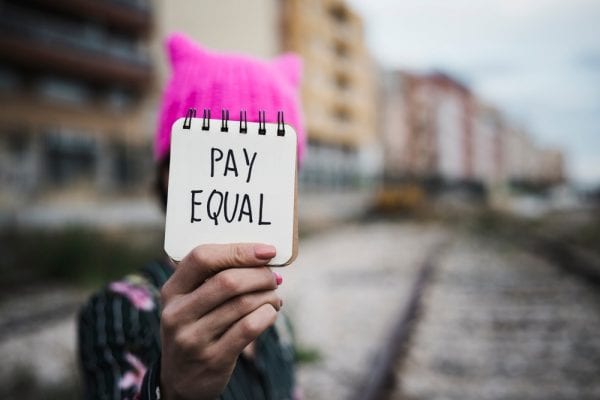The equal pay storm clouds have long been gathering on the horizon in many parts of the world and women, fed up with earning less than men in almost every profession, are going back to the barricades, so to speak, in pursuit of equal pay in spectacular fashion.
In the US, the renewed pursuit of passage of the Paycheck Fairness Act and the launch of the Time’s Up Pay Up campaign have both served as rallying points.
Just a few weeks ago, the actress Michelle Williams, who found out she was paid 1000 times less than her co-star Mark Wahlberg for re-shoots of the aptly named film “All the Money in the World”, gave an impassioned speech in Washington to rally the equal pay troops.
“Imagine a workplace where women don’t have to spend extra or any energy fighting for fair pay or defending their rights, but can instead focus that energy on the fullest expression of the task at hand and enjoy both the pride that brings and the product of that pride, which is fair and equal compensation for every woman,” said Williams.
Imagine indeed.
That sentiment was no doubt shared by the US women’s soccer team, who, in a move that might give other chronically underpaid female athletes around the world “funny ideas”, filed a suit against U.S. Soccer on International Women’s Day of this year claiming that they work just as hard as their male counterparts, but take home a fraction of the salary.
While the women’s team doesn’t take home as much dosh, they certainly do take home a lot more prizes compared to the men’s team – they have won three World Cup titles and four Olympic gold medals, while the men’s team failed to even qualify for the World Cup.
In the UK, equal pay was the second biggest news story last year behind the royal wedding, according to Elysia McCaffrey, the head of the UK’s Gender Equalities Office.
The elevation of equal pay to the top of the UK news agenda was due in no small part to Carrie Gracie, the former China Editor of the BBC, who spectacularly resigned from that post in 2017 upon discovering that she was being paid 50 percent less than the other male foreign editors.
Her appearance at a Parliamentary Select Committee convened to examine the issue of pay disparities at the UK’s national broadcaster is now the stuff of legend. Gracie systematically discounted the variety of “excuses” the BBC brass used to justify the disparity, including the spectacularly insulting suggestion that Gracie, who speaks fluent Chinese and has a Chinese degree, was “in development”.
Any woman in need of a bit of righteous indignation to rocket propel her innate sense of injustice regarding the gender pay gap need only watch, and perhaps re-watch, Carrie’s testimony. (I admit, I do this at regular intervals and pump my fist in the air).
The UK’s equal pay fires were further fanned by the introduction of mandatory equal pay reporting requirements in April of last year, which required all employers with more than 250 employees to publicly disclose their gender pay gap for the first time. The ensuing headlines proved damning for many employers, with significant gender pay gaps revealed at some of the UK’s most well-known brand names and across the public sector.
All relatively quiet on the Australian front
While many women abroad are demonstrating an equal pay revolutionary zeal not seen since the heights of second wave feminism, here in Australia the equal pay front has been relatively quiet, bar the occasional skirmish, such as high-profile journalist Lisa Wilkinson’s resignation from the Today Show in 2017, reportedly because Nine executives would not pay her the same as her male co-host. Or the formidable efforts of underpaid early years educators to address the low wages in the female dominated childcare sector.
Most tellingly, the 50th anniversary of Australia’s landmark first national equal pay case recently passed to little fanfare. Yes, it’s been 50 years since the legendary Zelda D’Aprano chained herself to the Melbourne Commonwealth Building to protest unequal pay, demonstrating precisely the kind of “old-school” equal pay zealotry many women abroad seem to be re-discovering, with a worthy Australian successor yet to emerge.
Is an Australian equal pay revolution nigh?
Why is that? Are conditions ripe for an equal pay conflagration should there be the necessary spark — ushering in a new equal pay reckoning in Australia? I hope so.
All of the UK and US examples have one thing in common: transparency, often unexpected but sometimes legislated, that threw into sharp relief the pay disparity between men and women and prompted an angry response.
The result? Women stuck their head above the parapet, met eyes, compared notes, and joined forces, just as happened following the shocking Weinstein revelations and the incredible outpouring of women’s common experiences of sexual harassment and assault that followed.
What had been so common, Molly Ringwald likened the ubiquity of harassment and assault to “the weather”, was now a thunderous rally of women banding together and saying no more. Likewise, on equal pay.
Australia hasn’t had a moment quite like that — yet. But that could change with the proposed introduction of mandatory equal pay reporting for companies with more than 1000 employees should a Labor government form in a few week’s time. Labor is also proposing to ban “secrecy clauses” that prevent employees telling colleagues how much they get paid.
“The pay transparency move could be a game changer in the equal pay campaign,” Professor of Gender, Work and Employment Relations Rae Cooper of the University of Sydney Business School told Women’s Agenda. “It feels like we now have had lots of conversations about pay equality,” she added. “I wish we could get to the fixing it bit.”
For those who ask whether such measures are really necessary, consider this shocking statistic from the Workplace Gender Equality Agency: 60% of those who voluntarily report their gender pay gap information to the agency – though that information is not made public – don’t do anything to address the gaps they identify.
Nothing. Nada. Zilch. Perhaps a bit of public naming and shaming will light a fire.
Or Australia might see more unexpected viral moments of gender pay gap transparency that capture the broader public, and women’s attention, such as the photo of the male and female winners of a surf competition last year, both holding checks displaying their remarkably different prize money.
According to a report in the Atlantic, the viral response to that photo helped create the “perfect storm” that delivered equal pay for women in surfing – in September of last year, the World Surf League announced that all male and female competitors would be paid equitably in all future WSL events.
One thing is clear: Pay transparency in itself is not a magic bullet, but it is a vital first step that could incite Australian women’s anger – and prompt large number to demand change and give them to the tools to hold employers accountable.
To paraphrase Arwa Mahdawi writing in the Guardian, the very same people who claim the gender pay gap is a myth are often those who most vehemently oppose any measures to introduce transparency. If it’s a myth, what are they so afraid of?
We might soon find out.



